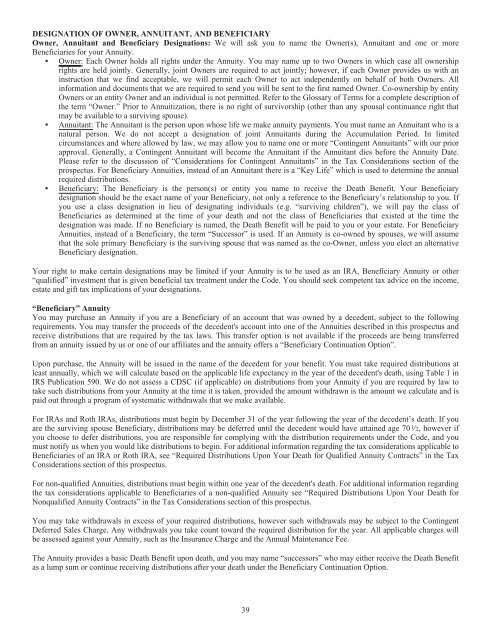Prudential Premier Retirement Variable Annuities
Prudential Premier Retirement Variable Annuities
Prudential Premier Retirement Variable Annuities
You also want an ePaper? Increase the reach of your titles
YUMPU automatically turns print PDFs into web optimized ePapers that Google loves.
DESIGNATION OF OWNER, ANNUITANT, AND BENEFICIARY<br />
Owner, Annuitant and Beneficiary Designations: We will ask you to name the Owner(s), Annuitant and one or more<br />
Beneficiaries for your Annuity.<br />
▪ Owner: Each Owner holds all rights under the Annuity. You may name up to two Owners in which case all ownership<br />
rights are held jointly. Generally, joint Owners are required to act jointly; however, if each Owner provides us with an<br />
instruction that we find acceptable, we will permit each Owner to act independently on behalf of both Owners. All<br />
information and documents that we are required to send you will be sent to the first named Owner. Co-ownership by entity<br />
Owners or an entity Owner and an individual is not permitted. Refer to the Glossary of Terms for a complete description of<br />
the term “Owner.” Prior to Annuitization, there is no right of survivorship (other than any spousal continuance right that<br />
may be available to a surviving spouse).<br />
▪ Annuitant: The Annuitant is the person upon whose life we make annuity payments. You must name an Annuitant who is a<br />
natural person. We do not accept a designation of joint Annuitants during the Accumulation Period. In limited<br />
circumstances and where allowed by law, we may allow you to name one or more “Contingent Annuitants” with our prior<br />
approval. Generally, a Contingent Annuitant will become the Annuitant if the Annuitant dies before the Annuity Date.<br />
Please refer to the discussion of “Considerations for Contingent Annuitants” in the Tax Considerations section of the<br />
prospectus. For Beneficiary <strong>Annuities</strong>, instead of an Annuitant there is a “Key Life” which is used to determine the annual<br />
required distributions.<br />
▪ Beneficiary: The Beneficiary is the person(s) or entity you name to receive the Death Benefit. Your Beneficiary<br />
designation should be the exact name of your Beneficiary, not only a reference to the Beneficiary’s relationship to you. If<br />
you use a class designation in lieu of designating individuals (e.g. “surviving children”), we will pay the class of<br />
Beneficiaries as determined at the time of your death and not the class of Beneficiaries that existed at the time the<br />
designation was made. If no Beneficiary is named, the Death Benefit will be paid to you or your estate. For Beneficiary<br />
<strong>Annuities</strong>, instead of a Beneficiary, the term “Successor” is used. If an Annuity is co-owned by spouses, we will assume<br />
that the sole primary Beneficiary is the surviving spouse that was named as the co-Owner, unless you elect an alternative<br />
Beneficiary designation.<br />
Your right to make certain designations may be limited if your Annuity is to be used as an IRA, Beneficiary Annuity or other<br />
“qualified” investment that is given beneficial tax treatment under the Code. You should seek competent tax advice on the income,<br />
estate and gift tax implications of your designations.<br />
“Beneficiary” Annuity<br />
You may purchase an Annuity if you are a Beneficiary of an account that was owned by a decedent, subject to the following<br />
requirements. You may transfer the proceeds of the decedent's account into one of the <strong>Annuities</strong> described in this prospectus and<br />
receive distributions that are required by the tax laws. This transfer option is not available if the proceeds are being transferred<br />
from an annuity issued by us or one of our affiliates and the annuity offers a “Beneficiary Continuation Option”.<br />
Upon purchase, the Annuity will be issued in the name of the decedent for your benefit. You must take required distributions at<br />
least annually, which we will calculate based on the applicable life expectancy in the year of the decedent's death, using Table 1 in<br />
IRS Publication 590. We do not assess a CDSC (if applicable) on distributions from your Annuity if you are required by law to<br />
take such distributions from your Annuity at the time it is taken, provided the amount withdrawn is the amount we calculate and is<br />
paid out through a program of systematic withdrawals that we make available.<br />
For IRAs and Roth IRAs, distributions must begin by December 31 of the year following the year of the decedent’s death. If you<br />
are the surviving spouse Beneficiary, distributions may be deferred until the decedent would have attained age 70 1 ⁄2, however if<br />
you choose to defer distributions, you are responsible for complying with the distribution requirements under the Code, and you<br />
must notify us when you would like distributions to begin. For additional information regarding the tax considerations applicable to<br />
Beneficiaries of an IRA or Roth IRA, see “Required Distributions Upon Your Death for Qualified Annuity Contracts” in the Tax<br />
Considerations section of this prospectus.<br />
For non-qualified <strong>Annuities</strong>, distributions must begin within one year of the decedent's death. For additional information regarding<br />
the tax considerations applicable to Beneficiaries of a non-qualified Annuity see “Required Distributions Upon Your Death for<br />
Nonqualified Annuity Contracts” in the Tax Considerations section of this prospectus.<br />
You may take withdrawals in excess of your required distributions, however such withdrawals may be subject to the Contingent<br />
Deferred Sales Charge. Any withdrawals you take count toward the required distribution for the year. All applicable charges will<br />
be assessed against your Annuity, such as the Insurance Charge and the Annual Maintenance Fee.<br />
The Annuity provides a basic Death Benefit upon death, and you may name “successors” who may either receive the Death Benefit<br />
as a lump sum or continue receiving distributions after your death under the Beneficiary Continuation Option.<br />
39

















